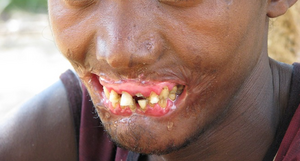Cancrum oris
| Noma | |
|---|---|
| Synonyms | cancrum oris, fusospirochetal gangrene, necrotizing ulcerative stomatitis, stomatitis gangrenosa |
 |
|
| A man afflicted with noma | |
| Classification and external resources | |
| ICD-9-CM | 528.1 |
| MedlinePlus | 001342 |
| MeSH | D009625 |
Noma is a rapidly progressive, polymicrobial, often gangrenous infection of the mouth or genitals.
The mucous membranes of the mouth develop ulcers, and rapid, painless tissue degeneration ensues, which can degrade tissues of the bones in the face.
In a condition sometimes called noma pudendi, noma can also cause tissue damage to the genitals.
Fusobacterium necrophorum and Prevotella intermedia are important bacterial pathogens in this disease process, interacting with one or more other bacterial organisms (such as Borrelia vincentii, Porphyromonas gingivalis, Tannerella forsythia, Treponema denticola, Staphylococcus aureus, and certain species of nonhemolytic .
It is often reported as a sequela to acute necrotising ulcerative gingivitis. Predisposing factors include:
The disease is associated with high morbidity and mortality and mainly affects children under the age of twelve in the poorest countries of Africa. Children in Asia and some countries of South America are also affected. Most children who get the disease are between the ages of two and six years old. The WHO estimates that 500,000 people are affected, and that 140,000 new cases are reported each year. The mortality rate is approximately 90 percent.
Known in antiquity to such physicians as Hippocrates and Galen, noma was once reported around the world, including Europe and the United States. With improvements in hygiene and nutrition, noma has disappeared from industrialized countries since the 20th century, except during World War II when it was endemic to Auschwitz and Belsen concentration camps. The disease and treatments were studied by Berthold Epstein, a Czech physician and forced-labor prisoner who had recommended the study under Josef Mengele's direction.
...
Wikipedia
